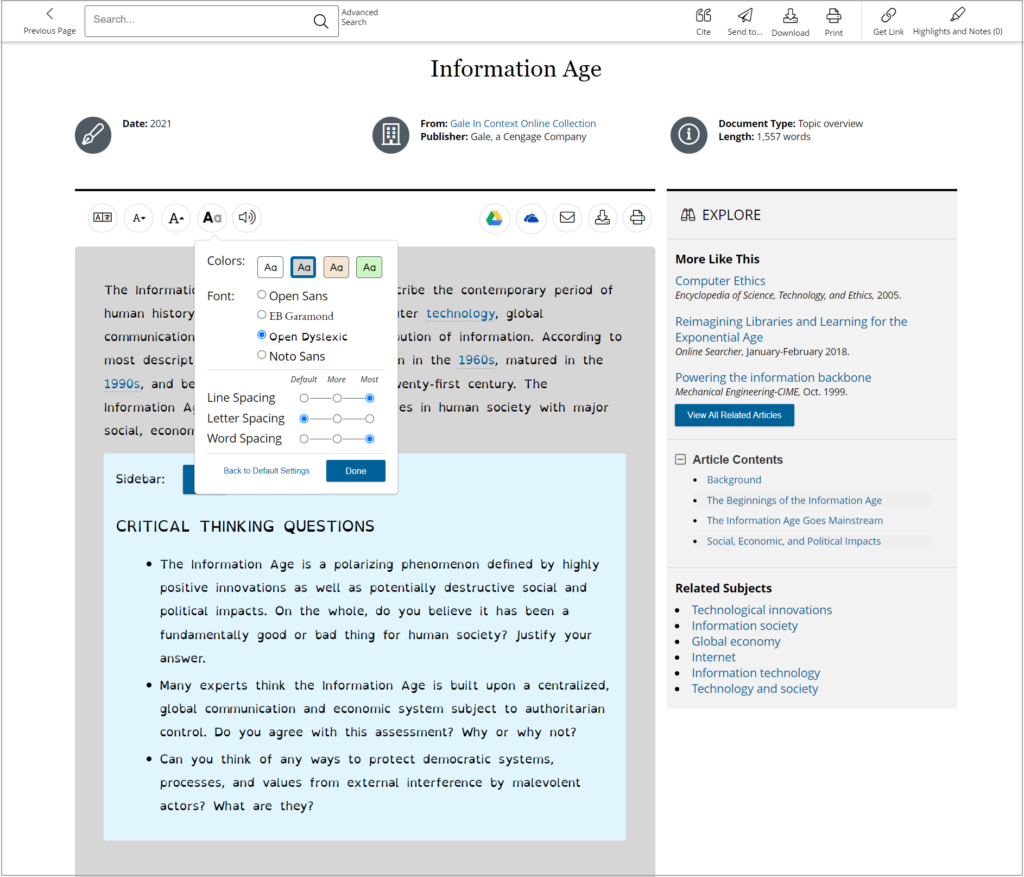| By Amy Wise, MLIS, Head Librarian, Grove City High School (OH) |
As head librarian at Grove City High School in Ohio, my biggest priority is connecting students to high-quality, curriculum-aligned resources—like those offered through Gale In Context and in collections on Gale eBooks.
To better support the varying needs of students, including those who may have reading disabilities, Gale recently updated text-display features within several of its digital resources. One change that’s been valuable is the addition of specialized fonts, like OpenDyslexic—which I recently experienced while hosting a book “speed dating” activity.
While the class perused the variety of books I placed on each table, I asked if anyone was having trouble “finding a date.” One student requested help, so I asked the usual questions: Are you a reader? What’s your favorite TV genre? He said reading would be one of his last choices to pass time, but he chose horror, so I pointed him in the right direction.
The student picked up The Legend of Sleepy Hollow, which is on the shorter side—about 70 pages. I proceeded to put my foot in my mouth by saying with a grin, “Let me guess, you looked for the smallest book on the table?”
He responded: “No . . . kind of. I think I’m dyslexic. You were in my social studies class last week and showed us the dyslexic font in the databases—it was amazing, you changed my life.”
Hearing that made my heart happy! It also drove home the importance of reading accessibility. I’m grateful to Gale for making tools like OpenDyslexic available in their resources to help our otherwise capable students be successful.
Digital Resources Support Accessibility
Whether students are reading for research or pleasure, school librarians play a key role in understanding their needs and connecting them to the right resources. This support is especially important for struggling readers.
Having materials available in multiple formats—such as large print and eBooks—ensures school libraries are equipped to meet more students’ needs. Equally important is ensuring that staff and students know how to take advantage of text-display and other accessibility features.
Reading struggles aren’t always apparent, and disorders like dyslexia often go undiagnosed. When speaking with students, I strive to avoid making assumptions, and instead focus on raising awareness of all available accessibility features.

To further enhance their reading experiences, I encourage students to play around with text and display tools, such as line, word and letter spacing; background colors; and text to speech.
Enhance the Reading Experience
As I was reminded during my book speed-dating experience, accessibility features are key for meeting the needs of all learners—especially those who could be struggling in private—and for enhancing the reading experience.
My advice for fellow librarians: Whether you’re assisting an individual student or entire class, share the tools that are available to them—regardless of if you think they’re going to need them or not. It could be life changing.
To learn how Gale is expanding accessibility with new text-display features, visit blog.gale.com/expanding-accessibility-with-new-text-display-features/.

Meet the Author
Amy Wise is the Head Librarian at Grove City High School in Ohio. She holds a Masters degree in Library and Information Science from Kent State University and has been a school librarian since 2001.

